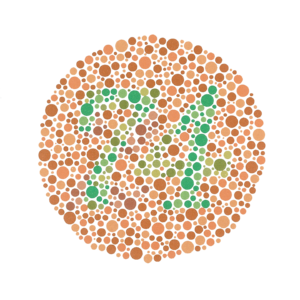Color blindness is a prevalent genetic disability which is more complicated than just seeing black and white.
Color blindness is a bit of a misnomer. Technically, the disability is better described as a color deficiency than blindness and many people have a misinformed idea about how people with a color deficiency see the world. It is not so much that a colorblind person cannot see color, it is a matter of seeing less color - an inability to distinguish as many hues as people with normal color vision.

What Causes Color Blindness
There are two types of photoreceptor cells in the human eye: rods and cones. Rods are active when seeing under dim light and cones are responsible for color vision. The cones split off into three types which correspond to blue (short), green (medium), and red (long) wavelengths. Color blindness occurs when one or more of these cones are absent or not functioning properly.
Types of Color Blindness
- Monochromacy - complete color blindness resulting from an absence of cones. Achromats only see in shades of gray, black, and white. Although this what most people imagine when thinking about color blindness, this type is extremely rare.
- Dichromacy - Less severe than monochromacy, only two of the three cone receptors are working properly, the third is either absent or not working at all. There are three types of dichromacy: protanopia - an absence of red cone receptors, deuteranopia - an absence of green cone receptors, and tritanopia - an absence of blue-yellow cone receptors.
- Anomalous Trichromacy - The most common type of color blindness in which all three types of cones are present, but one of the cones' spectral sensitivity is shifted, thus affecting the person's range of color. There are three types of anomalous trichormacy: protanomaly - "red-weakness", shades of red are brighter and shifted toward the green hue; deuteranomaly - "green-weakness", shades of green shifted toward red hue; and tritanomaly - rare compared to the other forms, there is a shift in perceiving blue-yellow hues.
- Red Green Color Blindness - The collective term for those with protanopia, deuteranopia, protanomaly, and deuteranomaly - those who have trouble with the red and green hues. Most colorblind people are red green color blind.
Tests for Color Blindness
- Ishihara Color Blind Test (Pseudoisochromatic Plate Test) - The iconic color blindness test developed by Dr. Shinobu Ishihara in 1917. The test employs plates with colored dots which have a hidden number or image. The test works better for identifying red green color blindness, but the test itself is not completely accurate and can lead to false positives.
- Color Arrangement Test - Using colored chips, the person is asked to arrange the chips according to similarity to a colored chip already in proper place. The test can be used to identifying the type of color blindness as well as the severity of it.
- Anomaloscope - The newest form of color blindness test in which the person is asked to adjust the brightness of a yellow color to match a variety of red and green colors.
References
Colorblind Home Page - General information site designed by Optometrist, Terrace L. Waggoner. colorvisiontesting.com
Colblindor - Articles, tests, and information from a colorblind person's perspective, "Color Blindness Viewed Through Colorblind Eyes."colblindor.com
Hi! I am a robot. I just upvoted you! I found similar content that readers might be interested in:
https://en.wikipedia.org/wiki/Color_blindness
Downvoting a post can decrease pending rewards and make it less visible. Common reasons:
Submit